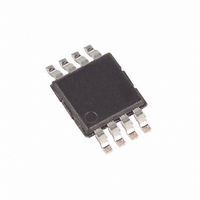DS1337U+ Maxim Integrated Products, DS1337U+ Datasheet - Page 9

DS1337U+
Manufacturer Part Number
DS1337U+
Description
IC RTC SERIAL 2WIRE LP 8-USOP
Manufacturer
Maxim Integrated Products
Type
Clock/Calendar/Alarmr
Datasheet
1.DS1337.pdf
(16 pages)
Specifications of DS1337U+
Time Format
HH:MM:SS (12/24 hr)
Date Format
YY-MM-DD-dd
Interface
I²C, 2-Wire Serial
Voltage - Supply
1.8 V ~ 5.5 V
Operating Temperature
-40°C ~ 85°C
Mounting Type
Surface Mount
Package / Case
8-MSOP, Micro8™, 8-uMAX, 8-uSOP,
Function
Clock/Calendar
Supply Voltage (max)
5.5 V
Supply Voltage (min)
1.8 V
Maximum Operating Temperature
+ 85 C
Minimum Operating Temperature
- 40 C
Mounting Style
SMD/SMT
Rtc Bus Interface
Serial (I2C)
Supply Current
150 uA
Lead Free Status / RoHS Status
Lead free / RoHS Compliant
Memory Size
-
Lead Free Status / Rohs Status
Lead free / RoHS Compliant
2
DS1337 I
C Serial Real-Time Clock
CLOCK AND CALENDAR
The time and calendar information is obtained by reading the appropriate register bytes. The RTC registers are
illustrated in
Table
2. The time and calendar are set or initialized by writing the appropriate register bytes. The
contents of the time and calendar registers are in the binary-coded decimal (BCD) format.
The day-of-week register increments at midnight. Values that correspond to the day of week are user-defined but
must be sequential (i.e., if 1 equals Sunday, then 2 equals Monday, and so on.). Illogical time and date entries
result in undefined operation.
When reading or writing the time and date registers, secondary (user) buffers are used to prevent errors when the
internal registers update. When reading the time and date registers, the user buffers are synchronized to the
internal registers on any start or stop and when the register pointer rolls over to zero.
The countdown chain is reset whenever the seconds register is written. Write transfers occur on the acknowledge
pulse from the device. To avoid rollover issues, once the countdown chain is reset, the remaining time and date
registers must be written within 1 second. The 1Hz square-wave output, if enable, transitions high 500ms after the
seconds data transfer, provided the oscillator is already running.
The DS1337 can be run in either 12-hour or 24-hour mode. Bit 6 of the hours register is defined as the 12- or
24-hour mode-select bit. When high, the 12-hour mode is selected. In the 12-hour mode, bit 5 is the AM/PM bit
with logic high being PM. In the 24-hour mode, bit 5 is the second 10-hour bit (20–23 hours). All hours values,
including the alarms, must be reinitialized whenever the 12/24-hour mode bit is changed. The century bit (bit 7 of
the month register) is toggled when the years register overflows from 99–00.
ALARMS
The DS1337 contains two time-of-day/date alarms. Alarm 1 can be set by writing to registers 07h–0Ah. Alarm 2
can be set by writing to registers 0Bh–0Dh. The alarms can be programmed (by the INTCN bit of the control
register) to operate in two different modes—each alarm can drive its own separate interrupt output or both alarms
can drive a common interrupt output. Bit 7 of each of the time-of-day/date alarm registers are mask bits
(Table
2).
When all of the mask bits for each alarm are logic 0, an alarm only occurs when the values in the timekeeping
registers 00h–06h match the values stored in the time-of-day/date alarm registers. The alarms can also be
programmed to repeat every second, minute, hour, day, or date.
Table 3
shows the possible settings.
Configurations not listed in the table result in illogical operation.
The DY/DT bits (bit 6 of the alarm day/date registers) control whether the alarm value stored in bits 0–5 of that
register reflects the day of the week or the date of the month. If DY/DT is written to logic 0, the alarm is the result of
a match with date of the month. If DY/DT is written to logic 1, the alarm is the result of a match with day of the
week.
When the RTC register values match alarm register settings, the corresponding alarm flag (A1F or A2F) bit is set
to logic 1. The bit(s) will remain at a logic 1 until written to a logic 0 by the user. If the corresponding alarm
interrupt enable (A1IE or A2IE) is also set to logic 1, the alarm condition activates one of the interrupt output (INTA
or SQW/INTB) signals. The match is tested on the once-per-second update of the time and date registers.
9 of 16












